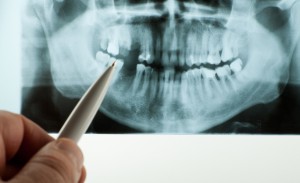 Dental x-ray images are a very important part of thorough oral exams. Some that contact us are worried about the possible side effects of x-ray radiation on their health. Be assured that ongoing technology improvements have effectively minimized the amount of radiation exposure involved with oral x-rays.
Dental x-ray images are a very important part of thorough oral exams. Some that contact us are worried about the possible side effects of x-ray radiation on their health. Be assured that ongoing technology improvements have effectively minimized the amount of radiation exposure involved with oral x-rays.
Dental X-Ray Safety
- First, the x-ray parts are shielded so that client exposure is limited to only the amount required for images of your teeth and jaw.
- Second, your internal organs are covered with a lead shield as a precaution to further minimize radiation exposure.
- Finally, your standard exposure in a dental image is considerably less than the radiation you receive from other medical x-rays or even from natural doses encountered from our environment. Walking in the sun each day actually provides you with a greater radiation dosage than a single oral x-ray.
It would require thousands of oral x-rays in one year before a patient might possibly experience any adverse effects. Certainly, the office of Rock Creek Dental doesn’t give any patient that many x-rays.
X-rays are very crucial for our Auburn dentist as they aid him to find any of the following problems:
- undiagnosed decay between teeth;
- bone loss due to periodontitis or other conditions;
- tumors, abscesses or cysts;
- developmental problems;
- impacted teeth (especially wisdom teeth).
Types of X-ray Imaging
Dentist associations advise annual bitewing x-ray images at a minimum (called such because you “bite” the tool used to make the picture). These let your Auburn dentist see the shape of your crowns and the height of bone between the teeth.
Full-set x-rays of the entire mouth are recommended every three to five years, giving a thorough view of every tooth in comparison to the bone and neighboring teeth.
Periapical x-rays take images of one tooth. This is typically done when a patient complains of a toothache, enabling our Auburn dentist to consider that tooth specifically.
A panoramic x-ray of your teeth and jaw, referred to as a Panorex, is taken without the patient placing anything in their mouth. Both the upper and lower jaw are seen together through one picture. This sort of picture is typically taken when treatment is needed to treat impacted teeth or to examine other suspected problems below the gum line.
As part of our Auburn dentistry practice, we only recommend x-rays essential to ensuring your oral well-being and safety. Every precaution and advancement possible for your long-term health is considered and used by the office of Rock Creek Dental. The diagnostic and preventative benefits are well worth the administration of this time-tested medical tool.
